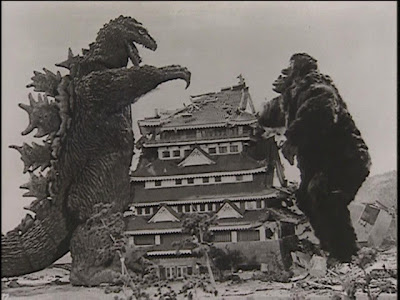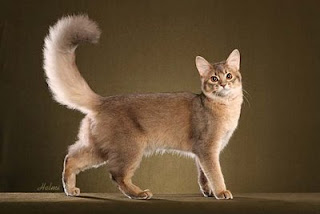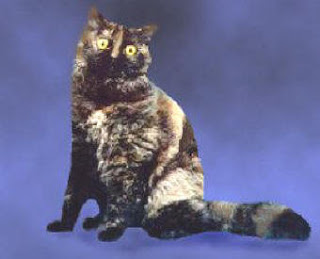The
Chausie Cat first historical record of the Jungle Cat was found in ancient Egypt, where both the Jungle Cat and the African Wild Cat were used for hunting wild waterfowl. Mummified Jungle Cats have been found in Egyptian tombs, attesting to the high regard in which they were held. Some say that the statues of the goddess Bastet were modeled after Jungle Cats and we can certainly see the resemblance in her long, slender body and large ears! The name,
Chausie, is derived from the Latin name for the Jungle Cat, Felis chaus, which occurs widely from the Nile Valley north to Turkey and the Caspian Sea, and eastward through South Asia as far as Vietnam.
Chausie Cat is a generic sounding term, and people sometimes assume it refers to any wild cat whose
habitat is jungle or forest. However, the Jungle Cat is a distinct species, with 9 subspecies, and is one of the largest of the small cats (genus Felis). In the wild, specimens have been reported weighing up to 40 lb. The chief habitats of the Jungle Cat are wetlands and river valleys. It preys on rodents and other small animals, but occasionally will eat the young of larger.
 |
| Chausie |
This
Chausie cat also flourishes in proximity to humanity, attracted by the rodents, which congregate in irrigated fields. In India, Felis chaus has been found nesting in abandoned granaries and houses. Probably because of this flexibility, Felis chaus populations are stable and the species is not considered endangered. Felis chaus is closely related to Felis sylvestris, which is widely considered to be the ancestor of modern domestic cats, and for this reason it is able to interbreed with domestic cats.
When people get their first glimpse of a
Chausie, especially one striding along in slinky, liquid motion,
they tend to be immediately struck with its elegant grace and agility. This breed is built for hunting,
running and jumping, and exudes the essence of "catness" which makes felines such intriguing
companions. The Chausie, pronounced "Chow-see" is a fully domestic breed derived from the Jungle
Cat. It is a statuesque cat: tall, upright, medium to largeframed, and regal in stance with the musculature of an agile hunter. Males are proportionately larger than females.
The
Chausies breed retains a strong resemblance to its wild ancestor, but is good-natured, loyal, intelligent and affectionate, as you would expect in a domestic cat. It is a highly active breed, and loves to play with toys or other cats. It retains this quality into adulthood.
Chausies come in three colors: brown ticked tabby, solid black and silver-tip, which are a color unique to this breed. The coat is short to medium, dense and relatively coarse. The tail is 3/4 to full length, and the ears are large, mobile, and can be lynx-tipped. The body is long and slender, and the legs are long, with small feet.
 |
| Chausie Cat |
The
Chausie is a statuesque cat, tall, upright, medium to large frame with legs more moderate in boning giving the cat a tall, slender legged look. Its musculature is that of an agile hunter with great jumping ability. They have large upright, tufted ears. Males will be proportionately larger than the females. The over-all appearance should bring to mind the Middle Eastern/Asian Jungle Cat as the breed retains a strong resemblance to it’s ancestor. This cat is good-natured, loyal and intelligent and should be amenable to handling showing no signs of challenge.
CHAUSIE BREED AND BREEDERS
CHAUSIE HEAD:
Shape: Modified wedge, medium in size with a long, sloping forehead and high ,angular, long cheekbones that meet a strong, full muzzle and chin. A change in direction at the sides of the muzzle gives the appearance of rounded whisker pads.
Eyes: Medium, slightly flattened oval and set on bias to just below the outside edge of the ear. Gold or yellow eye color preferred, hazel to light green allowed.
Profile: Long sloping forehead flows into the rise between the eyes, continuing down with good length, to meet the nose bump, which is rounded where it meets the convex nose leather.
Ears: Tall, large ears should be placed fairly close together on top of head with a wide base cornering the head and the ear set at a slight outward angle. The ear itself should be fairly wide all the way up with rounded ear tips. Ear tufts preferred, lack of tufts not a penalty.
Neck: The muscular neck is of
medium length and thickness.
Muzzle: Proportionate to the cheekbones and length of nose, with full
whisker pads.
Chin: Strong, full, both in profile and frontal view with depth resulting from good bone structure.
Nose: Medium-wide slightly broader between the eyes. Nose leather is convex and full.
CHAUSIE BODY:
Torso: Long, lean and muscular, firm to the touch; the large rectangular body is strong and athletic, with a balanced chest and good depth of body without any roundness of the ribcage.
Legs: The legs are moderately long, well muscled with medium boning. The hind legs are slightly longer than the
front, as the cat is built for running and leaping.
Feet: The feet are round and small in comparison to the overall size of the cat.
Tail: Three-quarter or full length tail acceptable; the 3/4 tail has fewer
vertebrae and is preferred. Both tail lengths should be of medium thickness and fully articulated.
Musculature: The musculature of the Chausie is long and lean rather than bulky.
Boning: The Chausie has medium leg boning with long, lithe legs, while the torso is substantial with good depth.
 |
| Chausie Cat |
CHAUSIE COAT/COLOR/PATTERN:
Length: Short to medium, with enough length to accommodate at least two bands of ticking. Not open. Texture: A dense, softer undercoat with a coarser resilient texture to outer coat.
CHAUSIE COLORS:
Black: Solid black.
Brown ticked tabby: A Mouse-gray color next to skin with sandy-gray to reddish gold base coat. There will be two or three bands of dark ticking following the mouse coat with tabby markings on the face, legs and tail. Bold barring on the upper inside of the front leg is preferred with lighter to no barring on the outside of the front leg. There may be faint barring on the back leg. Neck may or may not have neck-laces. Faint tabby markings on the body may be present but not preferred. A white or off white color should outline the eyes and muzzle. A Lighter underside is preferred
the stomach may appear flecked, speckled or spotted. The backs of ears will have “thumbprint” markings of a lighter color.
CHAUSIE Black Grizzled Ticked Tabby: A pattern effect caused by a mutation at the agouti locus or extension locus. It is a dominant trait. The hair shaft is banded with lighter coloration at the skin (akin to mouse coat) alternating dark and lighter bands of ticking and ending with a dark tip. The grizzled effect is the result of the use of the Jungle Cat (Felis Chaus) in the development of the Chausie breed. The Jungle Cat ancestor (black) exhibiting the grizzled effect has solid black nose leather and pink paw pads.
ALLOWANCES: Variation in tail length starting from just below the hock (3/4) to full length. Slight ghost body markings on kittens. Black paw pads with rosy or pink overtones allowed.
PENALIZE: Vivid green eyes. A cat that is too refined or too heavily boned. A cat void of tabby markings on the legs or tail.
WITHHOLD ALL AWARDS (WW): True classic pattern. Any colors other than the three allowable colors. White lockets.
DISQUALIFY (DQ): Tail too short, resulting from a mutated gene (MX/PB/BB). Tail kinked or lacking flexibility.



























































